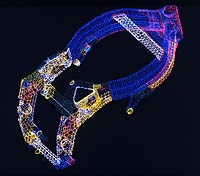|
Well, yes, the 16-inch
wheel is making a return, but that's only the beginning. American
Honda dragged us kicking and screaming (yeah, right) out to the
Las Vegas Motor Speedway, first for two days of Freddie Spencer's
High Performance Riding School and then for a full day of
riding the new 900RR on the AMA Superbike track -- high banks
and all. Although we were hesitant to believe it, the truth of
the matter is the new CBR900RR rocks! A few seemingly inconsequential
tweaks to engine and chassis have combined to make an animal of
an entirely different stripe.
The two peskiest demons
of the '96-'97 versions of CBR900RR were its very flexible chassis
and lightning-quick steering geometry. Some street riders disliked
its twitchy steering, while racers didn't care for the flex when
railing through corners. Honda clearly hopes to make all parties
happy with the new, 1998 setup.
About 17 percent less
flex in the chassis as a whole (close to 40 percent in the new
tapered swingarm) and a bit more trail makes for a planted-yet-flickable
ride, enjoyed immensely by both sportbike-initiate Associate
Editor Billy (cool-I-dragged-knee) Bartels and seasoned racer
Editor-in-Chief Brent (I've-been-hanging-out-with-Higbee) Plummer,
who turned the slowest and fastest laps, respectively, among
the assembled journalists.
All this chassis
stiffening, coupled with an advanced aerodynamic upgrade, resulted
in more pounds. So the engineers at Honda engaged in an aggressive
weight-loss plan, shaving pounds off of everything from the
engine to the new eight-plate clutch to the wafer-thin instrument
panel. In the end Honda claims the machine is now seven pounds
lighter than the 1997 model. Other enhancements include solid-lubed
pistons, new, authoritative front brakes, and a larger, curved
radiator.

Line Art/Technical
Drawings
Honda thoughtfully
brought along several '97 RRs for comparison. Hands down, the
1998 version spanks the old one. Leaving the garage, the first
thing noticed is a crisper throttle response. Throwing it at
the curves and banks of the Las Vegas Speedway, you are greeted
(depending on your style and skill level) by both an extremely
light-feeling machine that pulls strongly off corner exits (for
the recent race school grad) and a predictable mount that cleanly
slides the rear out of aggressively attacked corners (the racer-type).
After riding the
'98 RR, our neophyte sport-rider gave the '97 about four laps
before returning and hopping back on a '98. On sweepers, Bartels
complained of tucking the front with the '97 mount when he didn't
get on the gas quite soon enough. Boss-man Plummer didn't even
give it that many laps. He still had fever dreams from our 9 Vs. 9
shootout, and complained that the '97 900RR just didn't hold
a line like the '98. While the old 'Blade is arguably a quicker-turning
bike, the '98 features increased stability and forgiveness,
allowing its pilot to slam it into corners without a worry.
Besides, it's silly to call any 400-pound bike 'slow turning.'
All we can say is
that with the 1998 CBR900RR, a little bit goes a long way. Congratulations
Honda, but what took so long?
Specifications:
Story Posted December
2, 1997
|


